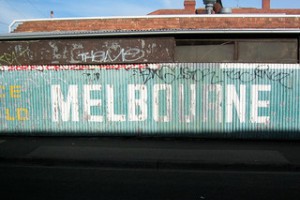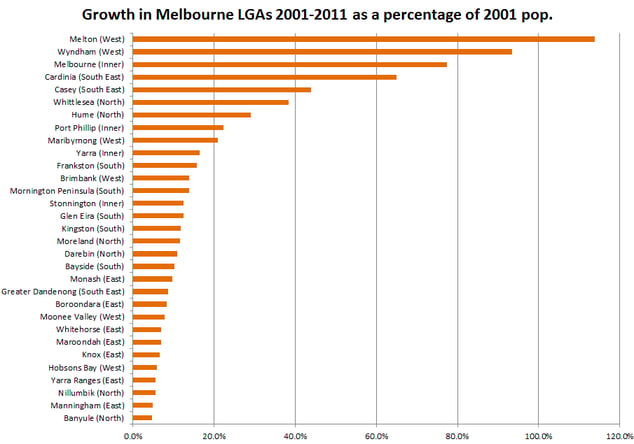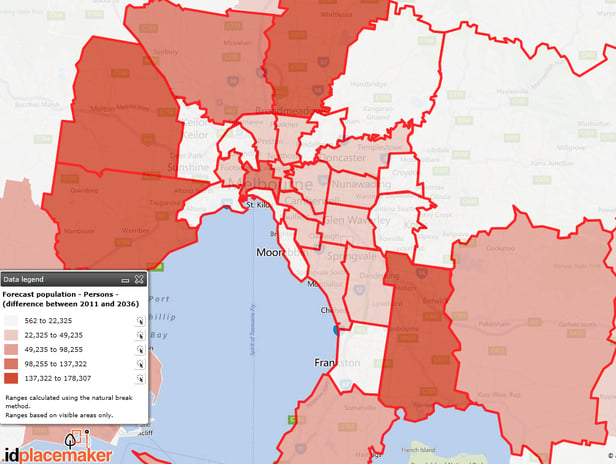Melbourne, the second-largest city in Australia, has been rapidly growing for some time. This blog looks at the distribution of Melbourne’s population and growth, and looks at the future, as well as the question of whether Melbourne will overtake Sydney.

What is Melbourne’s population?
The official population of Greater Melbourne is currently (June 2011) estimated at 4,137,432 by the Australian Bureau of Statistics. This is a preliminary estimate which may be revised after the Census data comes out, but nevertheless is likely to be close to the mark. Many people still think of Melbourne as a city of about 3 million, but it is now well over 4 million, and in the last 10 years has grown by about 660,000 people. In the same time Sydney has grown by 500,000, and remains about 490,000 larger than Melbourne, with Melbourne closing the gap.
Melbourne’s population in 2011 is about the same as Sydney’s was in 2001.
The ABS is redefining the geographic boundaries of capital cities based on the new geographic classification, which will be released later this year, and will add about 60,000 to Melbourne’s official population (they’ve always been there but are currently considered part of regional Victoria – places like Bacchus Marsh and Romsey), and nothing to Sydney’s. This will further close the gap.
The official definition of Melbourne currently consists of 31 Local Government Areas, and covers quite a broad area (over 8,000 square km), including all of the Mornington Peninsula, most of the Yarra Valley, and even as far east as Bunyip on the way to Gippsland.
Where is growth occurring?
Though the inner city is booming, and the City of Melbourne’s population is now almost 100,000, only 8% of Greater Melbourne’s population live in the inner suburbs. These are the areas visitors to Melbourne are most familiar with, like the CBD, Carlton, Fitzroy, St Kilda, Richmond etc (where most of the AFL teams are from!) The vast majority of Melbourne’s population are outside this area. And most of the growth in Melbourne in recent years has been on the fringe, where new suburbs are carved out of farmland. Most of the fringe growth of Melbourne happens in three corridors, the west, the north and the south-east.
While Melbourne’s eastern suburbs grew to a much greater extent than the west early on, most growth in the east is now confined to infill development, apart from the narrow south-eastern corridor of Casey-Cardinia. The west and north are now catching up, with the strongest fringe growth in places like Wyndham, Melton and Whittlesea. Here are the fastest growing LGAs in Melbourne over the last 10 years (in brackets I’ve shown the region of Melbourne each LGA falls into).

Source: Australian Bureau of Statistics, Regional Population Growth, Australia, 2010-11 (3218.0)
So most of the growth has been in the inner suburbs, or one of the three fringe growth areas. This differs from Sydney, where many mid-suburban areas have had large apartment redevelopments and represent the strongest growth. In Melbourne, infill, while occurring to some extent everywhere, has been strongest in the inner city, with new housing estates on the fringe housing the most new people.
Some of the fringe growth is just phenomenal. Wyndham in particular, on Melbourne’s western edge, is adding around 10-12,000 people every year, and nearby Melton adds around 6-8,000. This movement north and west is moving Melbourne’s centre of population. It still sits in the south-eastern suburbs in Glen Iris (Melway map 59) but is shifting each year slightly back towards the city now.
What will the population look like in the future?
So what of the future? .id undertakes population forecasts for the whole of Victoria, based on an average level of migration and region specific birth and death rates, as well as land availability assumptions for each area. According to the forecasts, Melbourne’s population will be approximately 5.7 million in the year 2036 (only 24 years away!) The fringe areas will continue to grow strongly, with Wyndham and Melton each piling on another 175,000 people, 138,000 more in Whittlesea, 178,000 more in Casey and 123,000 more in Hume. Inner City growth will also continue, with an extra 98,000 people in the City of Melbourne. In contrast, established outer suburbs such as Maroondah, Nillumbik, Knox and Frankston are expected to have only moderate growth.
Here is a map showing forecast LGA growth between 2011-2036, dominated by the outer fringe LGAs. For more detail on whether your suburb is likely to grow or decline by 2031, see our interactive forecast table for Melbourne suburbs on the .id website. More detailed forecast information is available by contacting .id.

Source: .id consulting population and household forecasts, 2006-2031, released December 2011
Will Melbourne’s population overtake Sydney’s?
And the all-important question, how will Melbourne compare to Sydney in 2036? Our forecasts show Melbourne at 5,730,000 and Sydney at 6,140,000, so Sydney will still be larger, but Melbourne will close the gap to about 410,000 people, and this is still on the basis of the old definitions. With the official change to the boundaries of what is called “Greater Melbourne” and “Greater Sydney”, and some growth spilling into these extended areas, it’s likely that the difference will be down to about 300,000 by then.
How can I access population forecasts?
Detailed population forecasts (including age structure) for CCDs, suburbs, LGAs and custom areas are available from .id. Please contact us for more information.
If you would like to receive more updates about demographic or economic trends, do follow us on twitter @dotid or subscribe to our blog (above). You may also like to visit us at id.com.au where you can access our demographic resource centre.














